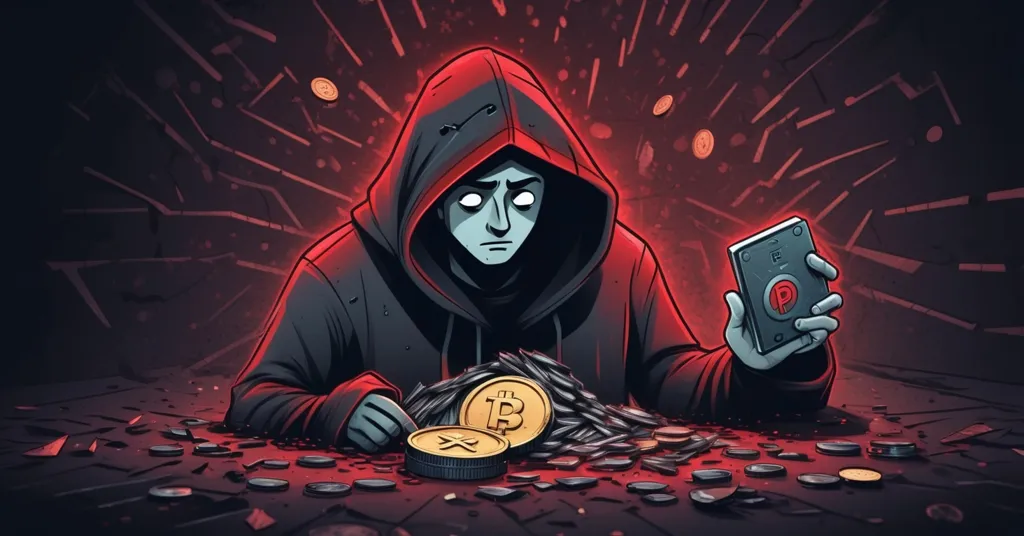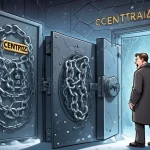ZachXBT Uncovers $3M XRP Theft: Crypto Security Flaws Exposed

ZachXBT Exposes $3 Million XRP Heist: A Brutal Wake-Up Call for Crypto Security
On-chain detective ZachXBT has uncovered a gut-wrenching $3.05 million theft of XRP from a US-based retail user, a stark lesson in the perils of user error and the shadowy depths of crypto crime. This incident, tied to a mishandled Ellipal hardware wallet, not only showcases individual mistakes but also lays bare systemic cracks in the industry—from inadequate user education to sophisticated laundering schemes linked to sanctioned entities like Huione Group.
- Massive Loss: $3.05 million (1.2 million XRP) stolen on October 12, 2025, due to user error with an Ellipal wallet.
- Laundering Path: Funds swapped to Tron via Bridgers, consolidated, and funneled to OTC desks tied to sanctioned Huione Group.
- Systemic Failings: User confusion, predatory recovery firms, and weak XRP community support highlight glaring industry gaps.
The Fatal Mistake: Cold to Hot Wallet Blunder
Picture losing $3 million overnight because of a single misclick. That’s the harsh reality for a US-based XRP holder who, on October 12, 2025, saw 1.2 million XRP—worth $3.05 million at the time—vanish from their Ellipal hardware wallet. According to ZachXBT, the renowned crypto sleuth who traced the theft and detailed the incident in a recent expose, the root cause was painfully simple: user error. The victim, likely inexperienced, imported their cold wallet seed phrase into a hot wallet, effectively leaving their digital vault wide open on the internet. For more on this breach, check out the detailed report on the $3 million XRP theft.
For the uninitiated, let’s break this down. A cold wallet, like Ellipal’s air-gapped hardware device, stores your cryptocurrency offline, making it a fortress against remote hacks. A hot wallet, by contrast, is online—think mobile apps or browser extensions—and while it’s handy for quick trades, it’s a juicy target for attackers. The seed phrase? That’s the master key, a string of words that unlocks your funds. Importing it from a secure cold wallet to a vulnerable hot wallet is like handing your safe’s combination to a thief on a silver platter. Ellipal was quick to defend their tech, stressing that the hardware itself wasn’t at fault.
“Our findings confirm that the loss occurred because the user mistakenly imported their cold wallet’s seed phrase into a hot wallet, which made the assets accessible online. Air-gapped cold wallets remain 100% offline and have never been compromised since launch.”
ZachXBT, however, pointed a finger at a deeper issue: the industry’s failure to prevent such confusion. Many wallet providers offer both custodial (where they hold your keys) and non-custodial (where you’re in full control) products, often with unclear branding or interfaces. This victim thought they were using Ellipal’s cold wallet app, not realizing it was a hot wallet setup.
“One lesson our industry needs to do better with is not causing confusion with products when you offer both custodial and non-custodial products. The XRP victim thought they were using the Ellipal cold wallet product when it was a hot wallet.”
This isn’t just a one-off oops. It’s a damning indictment of how poorly the crypto space educates its users. Hardware wallets are marketed as bulletproof, but they’re only as secure as the hands holding them. As a Bitcoin maximalist, I’ll argue that BTC’s ecosystem often does a better job with user guides and community-driven education, but even then, mistakes happen. Altcoins like XRP, while filling niches with faster, cheaper transactions, often lack the same grassroots safety net. Freedom in crypto comes with a steep learning curve—and a brutal price for slip-ups.
The Laundering Labyrinth: From XRP to Tron
While the victim reeled from their loss, the attacker moved with ruthless precision. Using Bridgers, a cross-chain swap platform formerly known as SWFT, they converted the stolen XRP to assets on the Tron blockchain, tapping Binance for liquidity. For clarity, cross-chain swaps let you move crypto between different blockchains—say, from Ripple’s ledger to Tron’s network—making it a nightmare to trace. By October 15, 2025, the funds were consolidated on Tron, a blockchain often criticized for its opacity and frequent use in shady dealings, before being funneled to over-the-counter (OTC) venues. These OTC desks are private trading platforms where crypto can be cashed out with far less scrutiny than public exchanges like Binance or Coinbase.
The final destination? Venues tied to Huione Group, a Cambodian financial network designated a “primary money laundering concern” by the US Treasury on October 14, 2025. These sanctions severed Huione’s ties to the US financial system, citing its role in laundering billions for Southeast Asian crime syndicates involved in pig butchering scams, human trafficking, and cyber hacks. ZachXBT didn’t hold back on the scale of their operations.
“Huione has directly facilitated laundering billions in illicit funds over the past couple years from pig butchering scams, investment scams, human trafficking and hacks/exploits in Southeast Asia.”
This laundering trail isn’t just a technical detail; it’s a window into how crypto crime has evolved into a high-stakes game of digital hide-and-seek. The use of cross-chain swaps and OTC desks shows a level of sophistication that outpaces many law enforcement agencies. Worse, Huione’s involvement links stolen crypto to real-world horrors, tainting the industry’s reputation and fueling regulatory crackdowns. As much as we champion decentralization, we can’t ignore that Bitcoin and altcoins alike get dragged through the mud when funds end up in such dark corners. It’s a brutal wake-up call: the freedom we fight for can be weaponized if we don’t address these systemic flaws.
No Help in Sight: Recovery Woes and XRP’s Isolation
If the theft wasn’t devastating enough, the aftermath for the victim is a masterclass in despair. ZachXBT highlighted a fatal hesitation in reporting the loss to competent private sector contacts, a delay that all but sealed the funds’ fate. Add to that the dismal state of law enforcement resources in the US for handling crypto thefts—often understaffed and out of their depth—and the odds of recovery plummet. Then there’s the crypto recovery industry, a cesspool where over 95% of firms, per ZachXBT, are nothing more than vultures preying on desperate victims with empty promises and hefty fees.
“Unfortunately the likelihood of this victim seeing any funds recovered is rather low due to a delay in reporting the theft to competent people within the private sector.”
Compounding the pain is the isolation faced by XRP holders. Unlike Bitcoin, Ethereum, Solana, or other EVM-compatible chains (networks that run smart contracts using Ethereum’s virtual machine), the XRP ecosystem lacks robust community support for theft victims. Whether due to Ripple’s centralized structure or simply less grassroots engagement, XRP users often find themselves stranded compared to Bitcoin’s battle-tested forums or Ethereum’s developer-driven recovery tools. With XRP trading at $2.44 at the time of the theft, the real-world impact of this $3 million loss hits even harder.
Let’s not mince words: this is a failure on multiple fronts. The industry must stop pretending user error is just a personal problem—it’s a collective liability. And while I’ll always argue Bitcoin offers a sturdier harbor with its decentralized ethos and community muscle, I can’t deny XRP and other altcoins serve purposes BTC doesn’t, like lightning-fast cross-border payments. But if ecosystems like XRP don’t build better safety nets, they risk alienating users who might otherwise flock to more resilient networks. It’s high time for altcoin communities to step up or face irrelevance.
Hardware Wallet Hype: Overpromised Security?
Let’s play devil’s advocate for a moment. Hardware wallet providers like Ellipal market their devices as the holy grail of crypto security—air-gapped, offline, unhackable. But are they overselling a false sense of invincibility to non-technical users? When a newcomer buys a device assuming it’s a set-it-and-forget-it solution, only to lose millions from a basic mistake, who bears the blame? Sure, personal responsibility is the bedrock of decentralization, and freedom isn’t free. But if wallet makers don’t prioritize idiot-proof design or crystal-clear education, they’re complicit in these disasters. A better UI to prevent hot/cold wallet confusion or mandatory security tutorials could save countless portfolios. On the flip side, no tech can fully protect against human folly—ultimately, you’ve got to own your mistakes in this game.
Broader Crypto Security Risks: A Ticking Time Bomb
Zooming out, this XRP heist is a microcosm of why crypto’s Wild West reputation lingers. User ignorance remains rampant; common blunders extend beyond seed phrase errors to phishing scams, fake wallet apps, and ignoring basic practices like verifying app authenticity before inputting sensitive data. Sophisticated crime networks, as seen with Huione’s billions in laundered funds, exploit these gaps with ease, while regulatory bodies tighten the screws—often justifiably. The US Treasury’s sanctions on Huione signal a broader crackdown on crypto-enabled crime, but it risks painting all of us as complicit if the industry doesn’t clean house.
Then there’s the support gap. Bitcoin and Ethereum communities often rally with advice, tools, and even crowdfunded recovery efforts. XRP? Crickets. This isn’t just about community spirit—it’s about survival. If altcoins can’t foster trust through support, they’ll hemorrhage users. And let’s be real: predatory recovery firms are a cancer, fleecing victims with no results. The crypto space needs to purge these scam artists with the same zeal we apply to exchange hacks. If we’re serious about effective accelerationism—pushing innovation to solve real problems—then tech solutions like multi-signature wallets (requiring multiple approvals for transactions) or smarter wallet interfaces must become standard, not optional.
What’s Next for Crypto Security?
This $3 million XRP theft isn’t just a cautionary tale; it’s a call to arms. Can crypto’s promise of financial freedom survive its perils, or are these million-dollar mistakes the inevitable cost of pioneering a new frontier? As we champion Bitcoin’s unshakable network and decentralization, we must also demand better from the broader blockchain space. User education needs to be relentless—think mandatory security checklists before wallet setup. Industry players like Ellipal must prioritize clarity over hype, while altcoin ecosystems like XRP have to build community muscle or risk fading. And regulators? They’ll keep cracking down unless we prove crypto can self-police. The path to mainstream trust is paved with harsh lessons, but if we double down on innovation and responsibility, these growing pains could forge a tougher, freer future.
Key Takeaways and Questions on Crypto Security
- What triggered the $3.05 million XRP theft in 2025?
User error—importing an Ellipal cold wallet seed phrase into a vulnerable hot wallet—exposed the funds to online theft. - How was the stolen XRP laundered across networks?
The attacker swapped XRP to Tron using Bridgers, leveraged Binance for liquidity, consolidated funds on Tron, and moved them to OTC desks tied to Huione Group. - Why does Huione Group’s role in crypto crime matter?
Sanctioned by the US Treasury, Huione launders billions for scams and trafficking, showing how stolen crypto fuels real-world crime and invites regulatory scrutiny. - Are hardware wallets safe after this XRP security breach?
Yes, when used correctly. Offline devices like Ellipal are secure, but user mistakes with seed phrases or app confusion can unravel all protection. - Why is recovering stolen crypto so challenging for victims?
Delayed reporting, inadequate law enforcement tools, predatory recovery scams, and weak XRP community support make restitution a near-impossible dream. - What broader crypto security risks does this heist expose?
It reveals persistent threats like user ignorance, advanced laundering schemes, poor altcoin support systems, and regulatory challenges that jeopardize crypto’s credibility.



